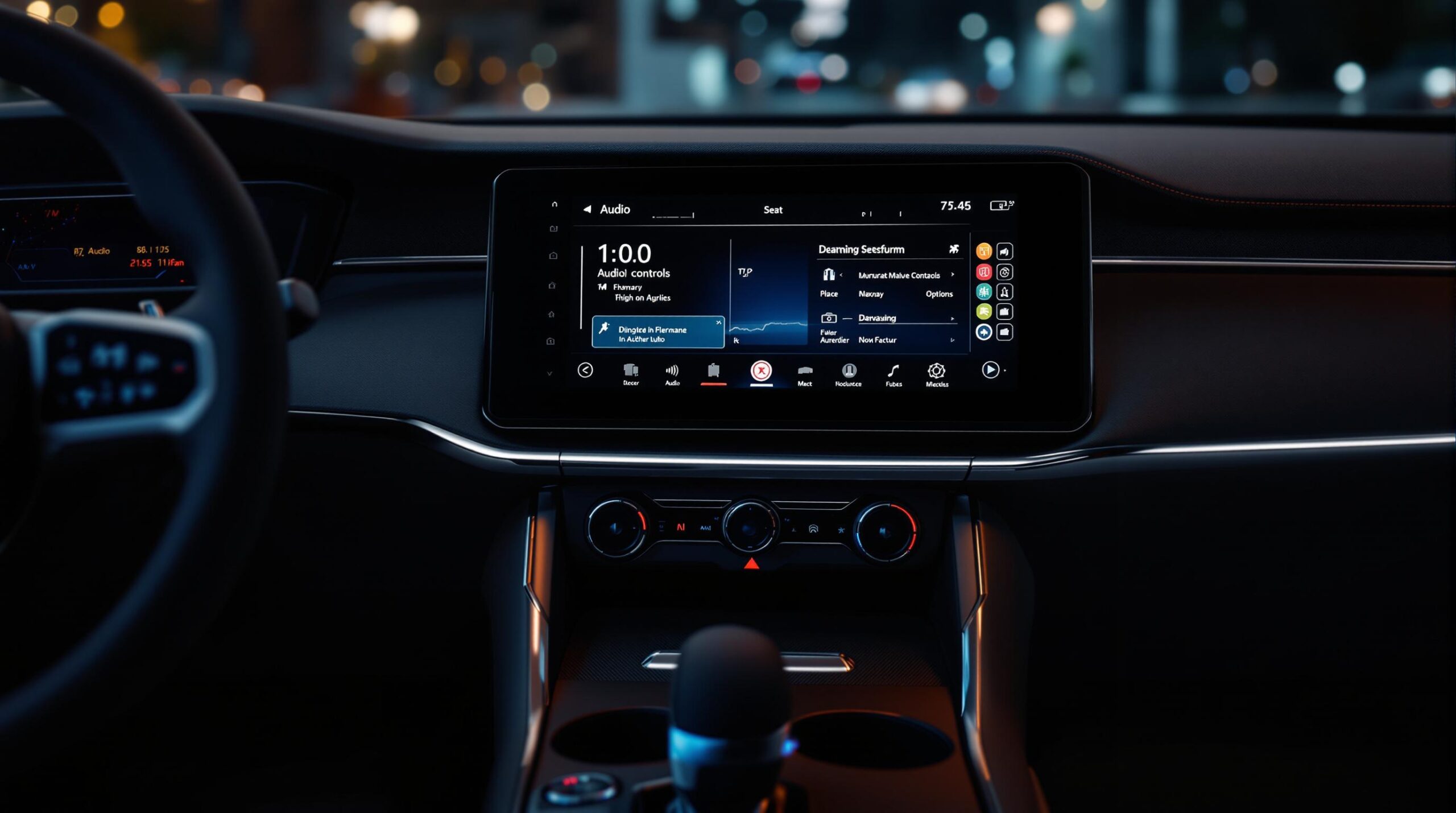
Audio hardware integration is the backbone of modern infotainment systems in vehicles, homes, and commercial spaces. It improves sound quality, supports hands-free features, and ensures seamless connectivity with devices like smartphones. Here’s what you need to know:
- Key Components: Systems include head units, amplifiers, connectivity modules (Bluetooth, USB, HDMI), and digital signal processors for sound optimization.
- Integration Methods: Vehicles use CAN and LVDS protocols for safety and reliability. Home systems rely on Wi-Fi and Bluetooth for multi-room setups, while commercial systems prioritize remote management and scalability.
- Challenges: Compatibility issues, connectivity problems (e.g., Bluetooth interference), and strict safety regulations must be addressed.
- Trends: AI-driven voice controls, advancements in wireless tech (Wi-Fi 6, 5G), and platforms like Android Automotive OS are shaping the future.
Quick Comparison
| System Type | Protocols | Key Features | Integration Focus |
|---|---|---|---|
| Vehicle | CAN, LVDS | Safety, hands-free, navigation | Integration with vehicle systems |
| Home | Wi-Fi, Bluetooth | Multi-room, app control | Smart home compatibility |
| Commercial | Wi-Fi, Ethernet | Remote management, scalability | Business-focused solutions |
Audio hardware integration ensures reliable, user-friendly systems tailored to specific environments. Whether enhancing vehicle safety or creating immersive home audio, it continues to evolve with AI and wireless advancements.
Solving Modern Factory System Integration Challenges
Components of Audio Hardware in Infotainment Systems
Modern infotainment systems rely on advanced hardware working together to deliver high-quality audio. Understanding these key components is crucial for successful integration across various setups.
Main Audio Hardware Elements
The head unit acts as the system’s command center, controlling operations through a touchscreen interface [1].
Here are the essential parts of a typical audio system:
| Component | Function | Features |
|---|---|---|
| Head Unit | Central Control Hub | Touchscreen, CAN protocol support |
| Amplifiers | Boosts Audio Signal | Signal processing, OEM compatibility |
| Connectivity Modules | Links External Devices | Bluetooth, HDMI, USB interfaces |
| Digital Signal Processors | Optimizes Sound | Audio correction, equalization |
JL Audio‘s FiX systems are a great example of maintaining factory features while improving audio quality [2]. These systems support a variety of formats like MP3, AAC, and FLAC, ensuring compatibility with different media sources [1].
Once these components are in place, integrating them with mobile apps becomes the next step.
Integration with Mobile Apps
Mobile apps have revolutionized how users interact with their infotainment systems. Modern platforms now support seamless smartphone connections through Android Auto and Apple CarPlay [1].
With mobile apps, users can access features like voice controls, wireless streaming, navigation, and hands-free communication.
Connectivity modules are key to this process, enabling communication via multiple channels:
“Connectivity modules link audio hardware to devices via Bluetooth (wireless) or USB/HDMI (digital)” [1].
Many systems also use sensors like proximity and gesture recognition to improve safety and ease of use [1]. Together, these hardware components and app integrations create a cohesive and intuitive infotainment experience.
Challenges in Audio Hardware Integration
Integrating audio hardware into infotainment systems comes with a range of technical and safety challenges that manufacturers and developers need to tackle.
Compatibility Problems
One of the biggest hurdles is ensuring compatibility. Modern infotainment systems must handle various audio formats while maintaining smooth interaction between different hardware components.
Here are some common compatibility issues:
| Challenge Type | Impact | Solution Approach |
|---|---|---|
| Format Support | Limited playback capabilities | Use multi-format decoders |
| Hardware Protocols | Communication barriers | Adopt CAN protocols |
| Legacy Systems | Issues with older electronics | Develop custom interfaces |
“Standardized protocols such as CAN (Controller Area Network) and LVDS (Low-Voltage Differential Signaling) can facilitate communication between different components and systems, reducing compatibility issues” [1].
Connectivity Issues
Reliable connectivity is another critical challenge. Problems like Bluetooth interference and signal instability can disrupt system performance.
Infotainment systems rely on technologies like Bluetooth for wireless streaming, Wi-Fi for high-bandwidth data, and USB or HDMI for direct connections. These challenges become even trickier in settings where multiple users need access at the same time, such as in commercial vehicles.
Safety and Compliance Requirements
Safety and compliance are non-negotiable in automotive audio systems. These systems must meet strict regulations while ensuring they don’t compromise driver safety.
Some key safety considerations include:
| Requirement | Purpose | Implementation |
|---|---|---|
| Driver Distraction Prevention | Reduce attention diversion | Integrate voice control |
| Emergency Override | Ensure critical announcements play | Enable priority audio routing |
| Volume Control Limits | Avoid hazardous sound levels | Use automatic level adjustment |
“Regulatory requirements and safety features are critical in automotive environments. For example, systems must comply with automotive safety standards and ensure that audio functions do not distract drivers or compromise vehicle safety” [1].
Manufacturers need to ensure that entertainment features don’t interfere with safety systems or distract drivers. Addressing these issues is crucial for creating reliable, user-friendly infotainment systems.
Best Practices for Integration
Use of Standardized Protocols
Standardized protocols like CAN and LVDS play a crucial role in ensuring smooth communication within audio hardware systems. These reliable standards, combined with modern connectivity options, help create well-rounded integration setups:
| Protocol | Benefits | Key Application |
|---|---|---|
| CAN/LVDS | Reliable system support | Core hardware communication |
| Bluetooth | Broad compatibility | Device connectivity |
| Wi-Fi | High-speed data transfer | Media streaming |
While these protocols handle the technical backbone, focusing on the user experience is just as important for successful integration.
Improving User Experience
Incorporating features like voice control, gesture recognition, and smartphone integration enhances both safety and convenience. Voice assistants help minimize distractions for drivers, while proximity sensors allow for touchless controls. Familiar platforms like Android Auto and Apple CarPlay provide users with interfaces they already know and trust.
“The integration of AI and voice control technologies can enhance user experience by providing intuitive and hands-free control over infotainment systems, improving safety and convenience” [1].
To bring these user-focused features to life, collaboration with the right development team is essential.
Choosing the Right Partners
Working with experienced partners is critical for effective integration. Seek out teams with proven skills in native app development, IoT integration, and adherence to safety standards. A strong partnership ensures solutions that meet technical needs while prioritizing usability and compliance with industry protocols.
Balancing technical reliability with user-focused design is key to building infotainment systems that are both intuitive and dependable, meeting the demands of modern connectivity.
Comparison of Audio Systems
Vehicle vs. Home/Commercial Systems
Audio system design varies significantly depending on the environment. In vehicles, the focus is on safety and system reliability, while home and commercial setups prioritize convenience and wireless functionality.
| System Type | Primary Protocols | Key Features | Integration Focus |
|---|---|---|---|
| Vehicle | CAN, LVDS | Safety features, vehicle controls | Integration with vehicle systems |
| Home | Wi-Fi, Bluetooth | Multi-room audio, IoT features | Smart home ecosystem compatibility |
| Commercial | Wi-Fi, Ethernet | Scalability, remote management | Business-focused scalability and remote access |
Commercial audio systems come at a wide range of price points. Basic setups can cost around $500, while mid-tier options range from $2,500 to $10,000. High-end installations can exceed $30,000 [3].
Examples: Sonos and TouchTunes
Modern audio systems aim to enhance user experiences through advanced integration techniques. For example, JL Audio’s FiX line of OEM Integration DSPs enables smooth integration with factory-installed head units in vehicles, all while preserving sound quality [2].
In home audio, Sonos stands out by offering:
- Reliable communication protocols paired with app-based control
- Multi-room audio capabilities and smart home compatibility
- User-friendly interfaces for managing the system
For commercial environments, TouchTunes focuses on:
- Handling large-scale user interactions
- Ensuring compliance with legal requirements and efficient content management
- Supporting payment systems and providing usage analytics
These examples highlight how tailored solutions address the specific needs of each environment. By using standardized protocols and working with experienced partners, developers can overcome the unique challenges of different audio system types.
Future Trends in Audio Hardware Integration
AI and Voice Control
AI is transforming infotainment systems by introducing predictive audio settings, natural language processing, and better contextual understanding. These systems can now adjust to driving conditions and handle conversational voice commands with ease [1].
Key improvements include:
- Predicting audio settings based on the environment
- Understanding context for more natural interactions
- Adapting in real-time to user preferences
As AI continues to refine user interactions, advancements in wireless technology are also playing a major role in improving connectivity and performance.
Advancements in Wireless Connectivity
Wireless technology is advancing rapidly, reshaping audio integration. Innovations like Bluetooth Mesh, 5G, and Wi-Fi 6 are enabling better connectivity, reduced latency, and higher bandwidth for tasks like streaming and multi-room audio [1].
| Technology | Key Benefits | Main Uses |
|---|---|---|
| Bluetooth Mesh | Connects multiple devices | Commercial audio systems |
| 5G Integration | Reduces latency | Streaming services |
| Wi-Fi 6 | Boosts bandwidth | Multi-room audio setups |
These technologies are paving the way for standalone platforms designed to unify hardware and software, offering a seamless user experience.
Development of Standalone Platforms
Standalone platforms such as Android Automotive OS are simplifying the integration of hardware and software, improving functionality and user experience. By combining AI-driven features with advanced wireless connectivity, these platforms are setting a new standard for audio hardware integration [1].
Key areas of focus include:
- Ensuring compatibility across devices and protocols
- Meeting safety and regulatory standards
- Designing intuitive interfaces and controls
“The development of standalone platforms like Android Automotive OS signals a shift towards more integrated and cohesive ecosystems. This could lead to more efficient and user-friendly audio hardware integration, as well as improved safety and security features” [1].
These platforms highlight how AI, wireless advancements, and integrated systems are shaping the future of audio hardware in vehicles, homes, and commercial spaces.
Conclusion: Key Points
This section focuses on the challenges, solutions, and future possibilities in integrating audio hardware into infotainment systems.
Overview of Challenges and Solutions
Integrating audio hardware into infotainment systems isn’t without its difficulties. Some of the main obstacles include compatibility issues, system complexity, and ensuring safety compliance. These challenges have been tackled using standardized protocols, collaboration with industry experts, and strict adherence to safety regulations. Technologies like CAN (Controller Area Network) and LVDS (Low-Voltage Differential Signaling) have played a pivotal role in addressing these issues effectively [1].
Thoughts on Future Developments
The world of audio hardware integration is changing quickly, shaped by new technologies and shifting user demands. For example, commercial sound systems, which can cost anywhere from $500 to $30,000, highlight the adaptability and range of today’s audio solutions [3]. These advancements are being applied across various settings, from vehicles to public spaces, each with its own set of challenges and opportunities.
The future success of audio hardware integration will rely on three main factors: adopting standardized protocols for smoother integration, creating user-friendly interfaces to improve accessibility, and forming strategic partnerships with technology specialists who can handle both current needs and upcoming trends [1].


